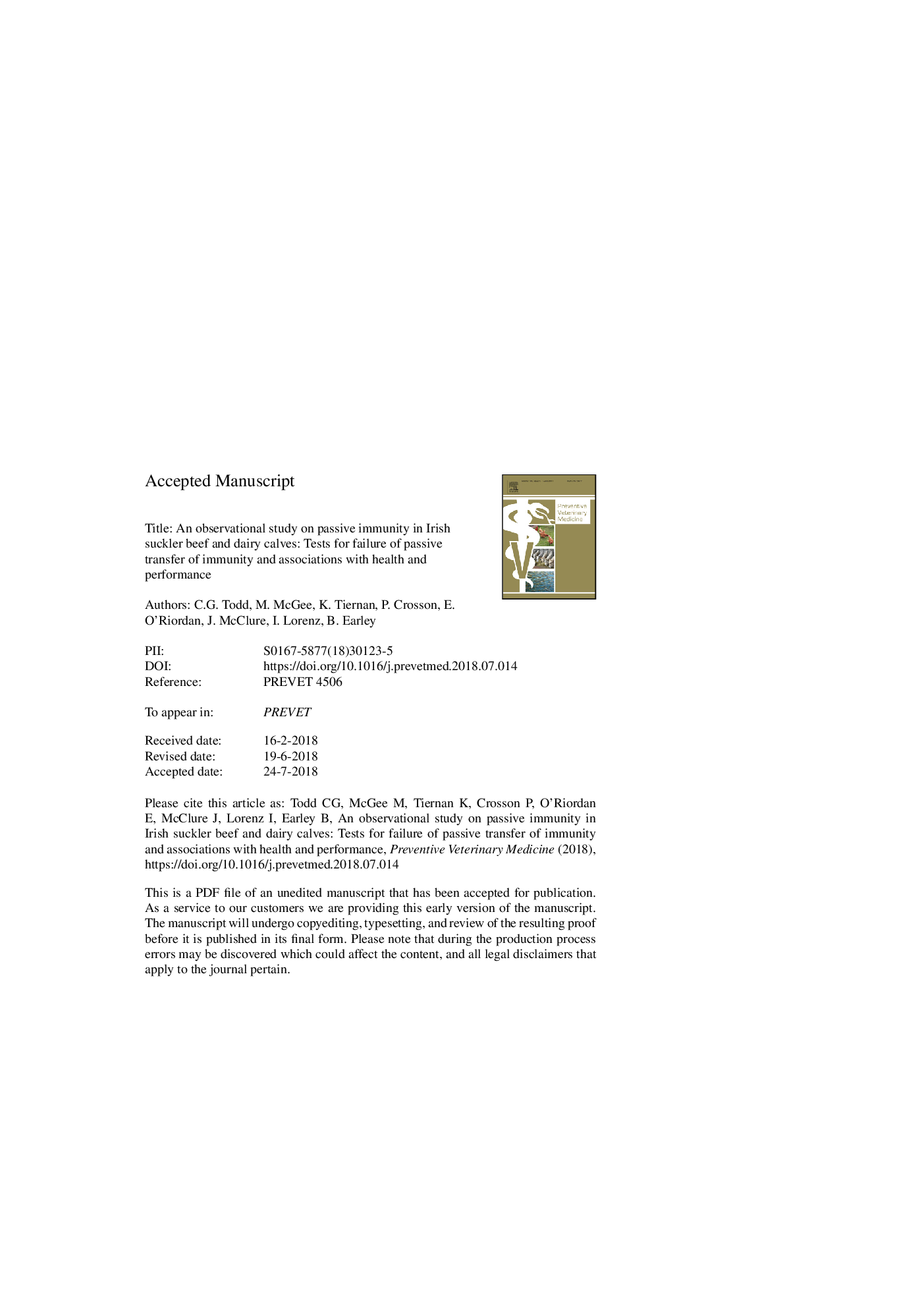| کد مقاله | کد نشریه | سال انتشار | مقاله انگلیسی | نسخه تمام متن |
|---|---|---|---|---|
| 11029256 | 1646561 | 2018 | 54 صفحه PDF | دانلود رایگان |
عنوان انگلیسی مقاله ISI
An observational study on passive immunity in Irish suckler beef and dairy calves: Tests for failure of passive transfer of immunity and associations with health and performance
ترجمه فارسی عنوان
یک مطالعه مشاهده ای در مورد ایمنی منفعل در گوساله های گوشت گاو و گوسفند شیرخشک ایرلندی: تست های شکستگی انتقال غیرفعال ایمنی و ارتباطات با سلامتی و عملکرد
دانلود مقاله + سفارش ترجمه
دانلود مقاله ISI انگلیسی
رایگان برای ایرانیان
کلمات کلیدی
BRDNPVIRRFPTPPVROCIgGAUC - AUCKnowledge transfer - انتقال دانشPassive immunity - ایمنی غیر فعالRadial immunodiffusion - ایمونودیفیسیون شعاعیimmunoglobulin - ایمونوگلوبولینimmunoglobulin G - ایمونوگلوبولین GBovine respiratory disease - بیماری تنفسی گاوEnzyme-linked immunosorbent assay - تست الیزاELISA - تست الیزاPar - توسطPopulation at risk - جمعیت در معرض خطرSensitivity - حساسیتrid - خلاص شدن از شرFailure of passive transfer - عدم انتقال غیرفعالMorbidity - عوارض جانبیconfidence interval - فاصله اطمینانDairy - لبنیاتMortality - مرگ ومیرarea under curve - منطقه تحت منحنیodds ratio - نسبت شانس هاincidence rate ratio - نسبت میزان بروزAIM - هدفSpecificity - ویژگیtotal protein - کل پروتئینCalf - گوساله، ساق پا، کالفreceiver operating characteristic - گیرنده عامل عامل
موضوعات مرتبط
علوم زیستی و بیوفناوری
علوم کشاورزی و بیولوژیک
علوم دامی و جانورشناسی
چکیده انگلیسی
The study objectives were to: 1) evaluate the diagnostic performance of passive immunity tests for classification of failure of passive transfer (FPT) risk, based on their relationships with calf health and performance, and 2) describe the epidemiology of morbidity and mortality in suckler beef and dairy calves under Irish conditions. A total of 1392 suckler beef calves (nâ=â111 farms) and 2090 dairy calves (84 farms) were included in this observational study. Blood samples were collected by jugular venipuncture. Serum samples were analysed for total IgG concentration using an ELISA assay, total protein concentration by clinical analyser (TP - CA), globulin concentration, zinc sulphate turbidity (ZST) units, total solids percentage by Brix refractometer (TS - BRIX), and total protein concentration by digital refractometer (TP - DR). Crude and cause-specific morbidity, all-cause mortality, and standardised 205-day body weight (BW) were determined. Generalised linear mixed models were used to evaluate associations between suckler beef and dairy calves for morbidity, mortality, growth and passive immunity. Receiver operating characteristic (ROC) curves were constructed to determine optimal test cut-offs for classification of health and growth outcomes. Overall, 20% of suckler beef and 30% of dairy calves were treated for at least one disease event by 6 mo. of age. Suckler beef calves had greater odds of bovine respiratory disease (BRD; odds ratio (OR), 95% confidence interval (CI): 2.8, 1.2-6.5, Pâ=â0.01), navel infection (5.1, 1.9-13.2, Pâ<â0.001), and joint infection/lameness (3.2, 1.3-7.8, Pâ=â0.01) during the first 6 mo. of life than dairy calves. In addition, from birth to 6 mo. of age, suckler beef calves had greater rates of navel infection (incidence rate ratio (IRR), 95% CI: 3.3, 1.3-8.4, Pâ=â0.01), but decreased rates of diarrhoea (0.9, 0.2-0.9, Pâ=â0.03) compared to dairy calves. Optimal test cut-offs for classification of morbidity and mortality outcomes in suckler beef calves ranged from 8 to 9 mg/ml ELISA, 56 to 61 g/l TP - CA, 26 to 40 g/l globulin, 12 to 18 ZST units, 8.4% TS - BRIX, and 5.3 to 6.3 g/dl TP - DR. Optimal test cut-offs for classification of morbidity and growth outcomes in dairy calves ranged from 10 to 12 mg/ml ELISA, 57 to 60 g/l TP - CA, 29 to 34 g/l globulin, 19 ZST units, 7.8 to 8.4% TS - BRIX, and 5.7 to 5.9 g/dl TP - DR.
ناشر
Database: Elsevier - ScienceDirect (ساینس دایرکت)
Journal: Preventive Veterinary Medicine - Volume 159, 1 November 2018, Pages 182-195
Journal: Preventive Veterinary Medicine - Volume 159, 1 November 2018, Pages 182-195
نویسندگان
C.G. Todd, M. McGee, K. Tiernan, P. Crosson, E. O'Riordan, J. McClure, I. Lorenz, B. Earley,
